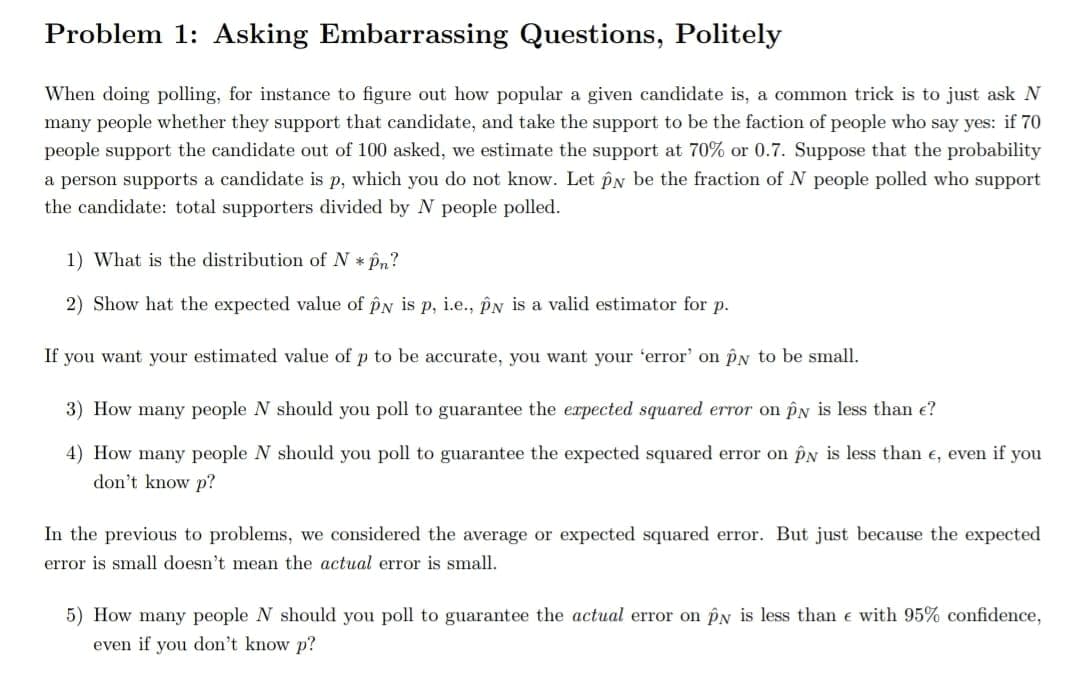When doing polling, for instance to figure out how popular a given candidate is, a common trick is to just ask N many people whether they support that candidate, and take the support to be the faction of people who say yes: if 70 people support the candidate out of 100 asked, we estimate the support at 70% or 0.7. Suppose that the probability a person supports a candidate is p, which you do not know. Let pN be the fraction of N people polled who support the candidate: total supporters divided by N people polled.
When doing polling, for instance to figure out how popular a given candidate is, a common trick is to just ask N many people whether they support that candidate, and take the support to be the faction of people who say yes: if 70 people support the candidate out of 100 asked, we estimate the support at 70% or 0.7. Suppose that the probability a person supports a candidate is p, which you do not know. Let pN be the fraction of N people polled who support the candidate: total supporters divided by N people polled.
MATLAB: An Introduction with Applications
6th Edition
ISBN:9781119256830
Author:Amos Gilat
Publisher:Amos Gilat
Chapter1: Starting With Matlab
Section: Chapter Questions
Problem 1P
Related questions
Question
please send handwritten solution for Q 2

Transcribed Image Text:Problem 1: Asking Embarrassing Questions, Politely
When doing polling, for instance to figure out how popular a given candidate is, a common trick is to just ask N
many people whether they support that candidate, and take the support to be the faction of people who say yes: if 70
people support the candidate out of 100 asked, we estimate the support at 70% or 0.7. Suppose that the probability
a person supports a candidate is p, which you do not know. Let PN be the fraction of N people polled who support
the candidate: total supporters divided by N people polled.
1) What is the distribution of N * Pn?
2) Show hat the expected value of pN is p, i.e., PN is a valid estimator for p.
If you want your estimated value of p to be accurate, you want your 'error' on PN to be small.
3) How many people N should you poll to guarantee the erpected squared error on PN is less than e?
4) How many people N should you poll to guarantee the expected squared error on PN is less than e, even if you
don't know p?
In the previous to problems, we considered the average or expected squared error. But just because the expected
error is small doesn't mean the actual error is small.
5) How many people N should you poll to guarantee the actual error on pN is less than e with 95% confidence,
even if you don't know p?
Expert Solution
This question has been solved!
Explore an expertly crafted, step-by-step solution for a thorough understanding of key concepts.
Step by step
Solved in 2 steps with 2 images

Recommended textbooks for you

MATLAB: An Introduction with Applications
Statistics
ISBN:
9781119256830
Author:
Amos Gilat
Publisher:
John Wiley & Sons Inc

Probability and Statistics for Engineering and th…
Statistics
ISBN:
9781305251809
Author:
Jay L. Devore
Publisher:
Cengage Learning

Statistics for The Behavioral Sciences (MindTap C…
Statistics
ISBN:
9781305504912
Author:
Frederick J Gravetter, Larry B. Wallnau
Publisher:
Cengage Learning

MATLAB: An Introduction with Applications
Statistics
ISBN:
9781119256830
Author:
Amos Gilat
Publisher:
John Wiley & Sons Inc

Probability and Statistics for Engineering and th…
Statistics
ISBN:
9781305251809
Author:
Jay L. Devore
Publisher:
Cengage Learning

Statistics for The Behavioral Sciences (MindTap C…
Statistics
ISBN:
9781305504912
Author:
Frederick J Gravetter, Larry B. Wallnau
Publisher:
Cengage Learning

Elementary Statistics: Picturing the World (7th E…
Statistics
ISBN:
9780134683416
Author:
Ron Larson, Betsy Farber
Publisher:
PEARSON

The Basic Practice of Statistics
Statistics
ISBN:
9781319042578
Author:
David S. Moore, William I. Notz, Michael A. Fligner
Publisher:
W. H. Freeman

Introduction to the Practice of Statistics
Statistics
ISBN:
9781319013387
Author:
David S. Moore, George P. McCabe, Bruce A. Craig
Publisher:
W. H. Freeman